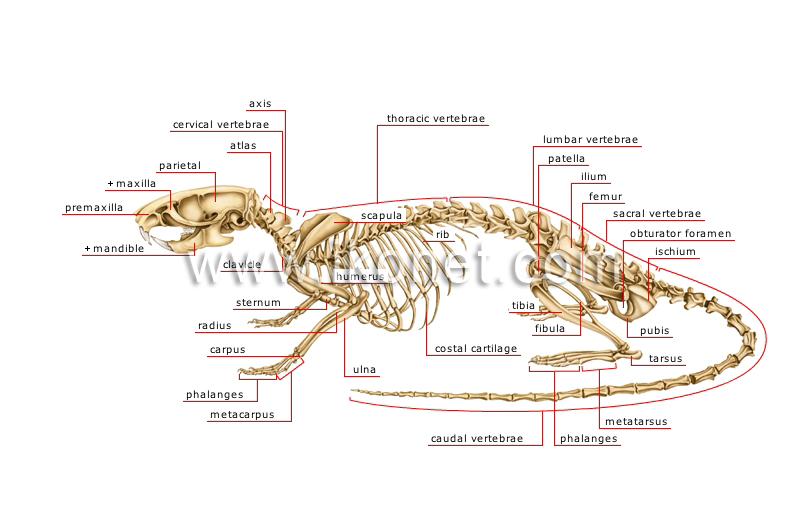Yes, rats, like all mammals, have a skeletal system composed of bones. This post will explore the anatomy of rats, focusing on their skeletal structure, which is both flexible and robust, allowing them to squeeze through incredibly tight spaces. Understanding the rat’s skeletal system helps explain their remarkable adaptability in various environments.
POINTS
- Rats have a complete skeletal system with a backbone made up of numerous vertebrae, which provides them with the flexibility needed to navigate tight spaces.
- The skeletal structure of a rat includes 223 to 230 bones, with slight variations due to the number of tail vertebrae among individual rats.
- Rats can squeeze through holes as small as half an inch in diameter, thanks to their flexible ribcage and spine, not because they have ‘collapsible skeletons.’
- While rats have strong gnawing instincts, which they use to keep their teeth at a manageable length, they do not typically eat bones as part of their diet.
- Understanding rats’ physical capabilities and behaviors, such as their ability to fit through small spaces and their dietary habits, is crucial for effective pest control and prevention.
Do Rats Have Bones in Their Body?
Many people wonder about the physical capabilities of rats, particularly their ability to navigate tight spaces. This curiosity often leads to the myth that rats do not have bones. To set the record straight, rats indeed have a complete skeletal system, just as other mammals do. Their bones are structured to support their bodies while allowing for a high degree of flexibility.
Comparison to Other Mammals
When we compare the skeletal structure of rats to other mammals, such as mice, we notice many similarities and a few differences. Both rats and mice belong to the rodent family and thus share a general body plan. However, rats are typically larger and have sturdier bone structures, which support their larger muscles and enable their strong, agile movements.
How Many Bones Does a Rat Have?

Rats possess a sophisticated skeletal system with a total number of bones ranging from 223 to 230. This count can vary slightly due to differences in tail vertebrae among individual rats.
Key Skeletal Features
One of the most notable features of a rat’s skeleton is its backbone. The backbone consists of numerous vertebrae, which play a critical role in rat mobility. This spinal structure provides the flexibility that rats need to twist and turn through their environment, contributing to their reputation as escape artists.
How Small of a Hole Can a Rat Fit Through?
Rats have a remarkable ability to squeeze through holes that appear much too small for them. This capability is often misunderstood, leading to the misconception that rats can flatten their bodies or have ‘collapsible skeletons.’ In reality, rats are simply very flexible and can contort their bodies to fit through tight spaces. The smallest hole a rat can fit through is commonly said to be about the size of a quarter, thanks to their flexible ribcage and spine.
Misconceptions About Rat Flexibility
The idea that rats have a ‘collapsible skeleton’ is a myth. Their bones are as solid as those of other mammals. However, their skeletal structure is designed to maximize movement and flexibility, allowing them to navigate through narrow openings without harm.
How Do Rats Fit in Small Spaces?
Rats are not just flexible; they are also incredibly smart and persistent, which aids in their ability to enter and navigate through confined spaces. A rat’s body is built for squeezing through gaps and holes, especially when foraging for food or escaping predators.
Anatomical Adaptability and Behavioral Traits
The anatomy of a rat includes a highly adaptable body structure. Their elongated, cylindrical shape and soft fur allow them to push through very small openings. Moreover, the design of their limbs, particularly their knees, enables them to collapse and fold close to their bodies, further reducing their effective size.
Limitations of Size
Despite their adaptability, there are limitations to the size of holes rats can exploit. Generally, an adult rat can squeeze through a hole or gap that is about half an inch in diameter. This is because their skull is the most rigid part of their body, and they cannot compress it to fit through smaller spaces.
Do Rats Eat Bones?
Rats are opportunistic feeders with a diet that can include a wide range of organic materials. However, bones are not a typical part of a rat’s diet. Rats prefer foods that are easier to consume and digest, such as seeds, fruits, grains, and occasionally animal protein.
Gnawing Behavior
Rats have a natural instinct to gnaw, which helps them keep their continuously growing teeth at a manageable length. This behavior can sometimes give the false impression that they consume bones. In reality, while they may gnaw on bones for the minerals or to wear down their teeth, they do not typically eat them.
Health and Nutritional Needs
Rats require a balanced diet to maintain their health, and they are known to eat almost anything available when necessary. However, they do not rely on bones as a food source. Instead, they seek out a variety of foods that provide them with the necessary nutrients to thrive.
Do Mice Have Bones?
Yes, mice have a skeletal system made up of bones. Their anatomy includes a skull, spine, ribs, and limbs, which provide structural support and protection for internal organs. The bones of a mouse are proportionately smaller and lighter than those of larger mammals, contributing to their agility and ability to navigate tight spaces. This skeletal framework is essential for their physical functions, including movement, and is adapted to their size and lifestyle as small, quick rodents.



